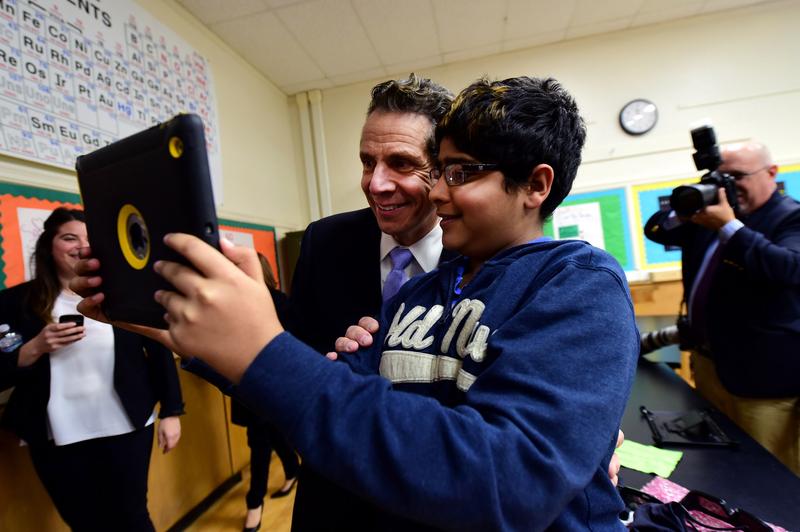
Education was front and center in Gov. Andrew Cuomo's budget presentation in Albany. His speech was even introduced by a public school teacher.
But Cuomo’s education proposals are controversial with the teachers unions and many Democrats. And the additional $1.1 billion in education aid he budgeted is just about half of what the Board of Regents requested. Nonetheless, he's using those funds as leverage by tying them to his proposals.
“I understand the political consequence of what I’m asking you to do in making these reforms,” he stated. “But if we want to really invest in the system then make it the right system. And don’t ask the taxpayers of New York to throw good money after bad.”
Here are the big items:
Teacher Evaluations
Cuomo called the current teacher evaluation system “baloney.” He noted that almost 99 percent of high school teachers got effective ratings last year, even though just 38 percent of students graduate ready for college.
Cuomo wants to change the current formula, which relies on classroom observations for 60 percent of the teacher’s rating, student scores on state tests for 20 percent and local measures for the remaining 20 percent. He says those local measures have wound up creating too many tests. He now wants to simplify the process by making student progress on state exams count for half of the teacher’s rating, with classroom observations accounting for the other half.
New York City teachers union president Michael Mulgrew called the governor’s speech "warmed-up Bloomberg leftovers" that “ignore the real problems, and blame the teachers for everything that’s wrong.”
The group Educators 4 Excellence, which represents teachers who don't always take the same position as their union, was more circumspect. Executive Director Jonathan Schleifer said he was glad to see a focus on teacher evaluation, but he had concerns about the increased weight of test scores and the diminished role of principals.
Changing the teacher evaluation law will require getting Assembly Democrats on board. On Wednesday, Speaker Sheldon Silver said he needs to look at the details. But in the past, he’s said he doesn't want to give more weight to test scores. He thinks the current system should refine ways of identifying teachers who need help.
Experts have looked at how much weight should be given to test scores and 50 percent is the maximum they've recommended.
Teacher Tenure
Cuomo wants to raise the probationary period for tenure from three years to five years. This mirrors a suggestion by Regents Chancellor Merryl Tisch.
The group StudentsFirstNY, which has taken on the teachers union and lobbied for more charter schools, pointed to studies showing teachers need more than three years to become effective. Executive Director Jenny Sedlis praised the governor and said it "takes an enormous amount of courage to stand up to entrenched special interests."
Removing and Rewarding Teachers
Cuomo said he would expedite the process for removing teachers who get poor ratings. “We propose allowing a district to remove a teacher after two ineffective ratings unless the teacher can prove the scoring was fraudulent,” he said.
At the same time, Cuomo would make it possible for teachers with the best rating to receive a $20,000 bonus. He said this would “incentivize” the best teachers to remain in the system.
He’d also have the state pay the tuition of the top SUNY and CUNY graduates who commit to teaching for at least five years.
Charter Schools
Cuomo would allow 100 more charters throughout the state, for a total of 560, without tying them to any specific districts. This would benefit New York City, which is fast approaching its limit of about 250 charters. He also proposed an “anti-creaming” provision that requires charters to submit enrollment rates to the state for the number of students receiving free lunch, English Language Learners and students with disabilities at the beginning and end of each school year. These reports would be bimonthly during the five-year period in between charter re-authorizations.
Republicans support more charters. But Silver said Wednesday he’s “not sure if it’s urgent to raise the cap,” because there are still so many unused charters from upstate regions that could go to New York City.
New York City Charter School Center C.E.O. James Merriman said the governor had shown “bold leadership and willingness to take on big issues.”
Failing Schools
Any school that has been failing for three straight years would be taken over by a not-for profit or another district. They would have to create a plan to dramatically improve the school by overhauling the curriculum, overriding staff agreements and terminating under-performing staff. They’d also provide salary incentives and create a community schools model, with pre-k for elementary schools and early college programs for secondary schools. The state has identified 178 failing schools.
Education Tax Credit
A $100 million dollar education tax credit for public and private scholarships, tied to $27 million for the DREAM Act to help undocumented immigrants obtain college aid.
